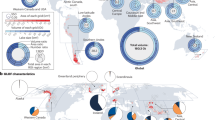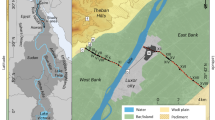Abstract
TECTONOMAGNETISM—the study of magnetic anomalies due to tectonic stresses—is attracting increasing interest as a method of monitoring local changes in Earth stress1. The most important aspect is the search for the seismomagnetic effect; no convincing observation has yet been reported, although calculations2,3 indicate that in many cases it must be of measurable magnitude, and observations of magnetic precursors to creep increments on the San Andreas fault4 encourage the view that magnetic effects of earthquakes themselves are observable. Local magnetic changes preceding and accompanying volcanic eruptions in New Zealand are very striking5,6 and indicate that substantial stresses are associated with eruptions; a quite different pattern of volcanomagnetic changes in Hawaii (P. D., F. S., Jackson and Field, to be published) suggests that Kilauea volcano is highly fragmentednd a incapable of supporting a large scale stress pattern. But both volcanic eruptions and the San Andreas creep increments are very imperfectly understood so that a large scale control experiment which demonstrates quantitatively the role of the piezomagnetic effect in producing local magnetic anomalies is very desirable. The requirement is satisfied by the water loads imposed on underlying strata by man-made lakes, which provide large scale Earth stresses of sufficient intensities to produce measurable magnetic anomalies. Recent completion of a new dam at Talbingo in the Snowy Mountains of SE Australia and rapid filling of the reservoir provided an opportunity to observe this effect.
This is a preview of subscription content, access via your institution
Access options
Subscribe to this journal
Receive 51 print issues and online access
$199.00 per year
only $3.90 per issue
Buy this article
- Purchase on Springer Link
- Instant access to full article PDF
Prices may be subject to local taxes which are calculated during checkout
Similar content being viewed by others
References
Nagata, T., Intern. Ass. Geomagn. Aeron. Bull., 27, 12 (1969).
Stacey, F. D., Pure Appl. Geophys., 58, 5 (1964).
Shamsi, S., and Stacey, F. D., Bull. Seism. Soc. Amer., 59, 1435 (1969).
Breiner, S., and Kovach, R. L., Tectonophysics, 6, 69 (1968).
Johnston, M. J. S., and Stacey, F. D., J. Geophys. Res., 74, 6541 (1969).
Johnston, M. J. S., and Stacey, F. D., Nature, 224, 1289 (1969).
Stacey, F. D., Barr, K. G., and Robson, G. R., Pure Appl. Geophys., 62, 96 (1965).
Stacey, F. D., and Johnston, M. J. S., Pure Appl. Geophys., 97, 146 (1972).
Snowy Mountains Hydroelectric Authority, Geological Map, T11/223 (1966).
Gough, D. I., and Gough, W. I., Geophys. J., 21, 65 (1970).
Author information
Authors and Affiliations
Rights and permissions
About this article
Cite this article
DAVIS, P., STACEY, F. Geomagnetic Anomalies caused by a Man-made Lake. Nature 240, 348–349 (1972). https://doi.org/10.1038/240348a0
Received:
Issue Date:
DOI: https://doi.org/10.1038/240348a0
This article is cited by
-
Tectonomagnetic study in the eastern part of Hokkaido, NE Japan: Discrepancy between observed and calculated results
Earth, Planets and Space (2014)
-
EM Monitoring of Crustal Processes Including the Use of the Network-MT Observations
Surveys in Geophysics (2007)
-
The piezomagnetic computation of magnetic anomalies due to ground loading by a man-made lake
Pure and Applied Geophysics PAGEOPH (1974)
Comments
By submitting a comment you agree to abide by our Terms and Community Guidelines. If you find something abusive or that does not comply with our terms or guidelines please flag it as inappropriate.



